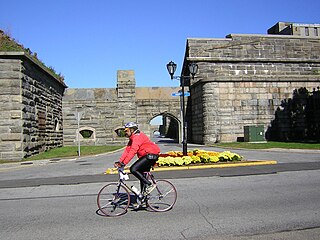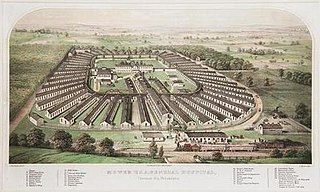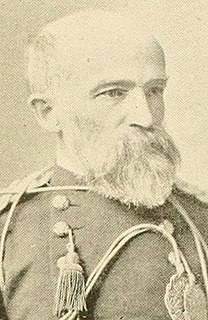
Fort Schuyler is a preserved 19th century fortification in the New York City borough of the Bronx. It houses a museum, the Stephen B. Luce Library, and the Marine Transportation Department and Administrative offices of the State University of New York Maritime College. It is considered one of the finest examples of early 19th century fortifications. The fort was named in honor of Major General Philip Schuyler of the Continental Army.

USS Fort Jackson was a wooden sidewheel steamer in the United States Navy during the American Civil War. She was successful in enforcing the Union blockade of Confederate ports, capturing five ships carrying contraband. She participated in the battles for Fort Fisher, which effectively closed the port of Wilmington, North Carolina to the Confederacy. Most notably, the surrender of Confederate forces in Texas was signed aboard the ship, formally ending the Civil War in that portion of the country.

The United States Sanitary Commission (USSC) was a private relief agency created by federal legislation on June 18, 1861, to support sick and wounded soldiers of the United States Army during the American Civil War. It operated across the North, raised an estimated $25 million in Civil War era revenue and in-kind contributions to support the cause, and enlisted thousands of volunteers. The president was Henry Whitney Bellows, and Frederick Law Olmsted acted as executive secretary. It was modeled on the British Sanitary Commission, set up during the Crimean War (1853-1856), and from the British parliamentary report published after the Indian Rebellion of 1857.

Satterlee General Hospital was the largest Union Army hospital during the American Civil War. Operating from 1862 to 1865 in Philadelphia, Pennsylvania, its physicians and nurses rendered care to thousands of Union soldiers and Confederate prisoners. After its patient population spiked following the battles of Bull Run and Gettysburg, this hospital became the second-largest in the country with 34 wards and hundreds of tents containing 4,500 beds.

Mower General Hospital was one of the largest Federal military hospitals during the American Civil War. Located across from the Reading Railroad depot in the Chestnut Hill section of Philadelphia, it operated from January 1863 through May 1865, and was closed with the cessation of the war.

New York City during the American Civil War (1861–1865) was a bustling American city that provided a major source of troops, supplies, equipment and financing for the Union Army. Powerful New York politicians and newspaper editors helped shape public opinion toward the war effort and the policies of U.S. President Abraham Lincoln. The port of New York, a major entry point for immigrants, served as recruiting grounds for the Army. Irish-Americans and German-Americans participated in the war at a high rate.

Joseph K. Barnes was an American physician and the 12th Surgeon General of the United States Army (1864–1882).
Brown General Hospital was a military medical facility erected by the Union Army in Louisville, Kentucky, during the American Civil War. It was the largest of six general military hospitals scattered throughout the city. Army surgeons administered the hospital, aided by civilian agencies such as the United States Sanitary Commission and the U.S. Christian Commission.
Archibald Livingston McDougall was an officer in the Union Army during the American Civil War who commanded the 123rd New York Volunteer Infantry early in the war and subsequently led a brigade at the Battle of Gettysburg.

Nevada's entry into statehood in the United States on October 31, 1864, in the midst of the American Civil War, was expedited by Union sympathizers in order to ensure the state's participation in the 1864 presidential election in support of President Abraham Lincoln. Thus Nevada became one of only two states admitted to the Union during the war and earned the nickname that appears on the Nevada state flag today: "Battle Born".

The state of New York during the American Civil War was a major influence in national politics, the Union war effort, and the media coverage of the war. New York was the most populous state in the Union during the Civil War, and provided more troops to the U.S. army than any other state, as well as several significant military commanders and leaders. Approximately 400,000 New York State citizens served in the US armed forces during the war, and 54,000 died in battle, from disease, or in enemy camps.

The 1st New York Engineer Regiment was an engineer regiment that served in the Union Army during the American Civil War. It was also known as Serrell's Engineers, New York Volunteer Corps of Engineers, or Engineer's and Artizans. The regiment served initially in the Lower Seaboard Theater, and later in the Richmond–Petersburg Campaign.
The District of California was a Union Army command department formed during the American Civil War. The district was part of the Department of the Pacific, the commander of the department also being District commander. The district was created as a separate command on July 1, 1864, after Irvin McDowell took command of the Department of the Pacific, relieving General Wright, who then remained as District of California commander. The District comprised the state of California and the areas of the Rogue River and Umpqua River in Southern Oregon. Its headquarters were in San Francisco, co-located with those of the Department of the Pacific. On March 14, 1865, the District of Oregon was extended to include the entire state of Oregon, removing the Rogue River and Umpqua River areas from the District.
Joseph Nelson Garland Whistler was a career United States Army officer. He served in the Mexican–American War and received a brevet appointment for distinguished service in the Battle of Contreras and the Battle of Churubusco. At the beginning of the American Civil War, Whistler was among the U.S. Regular Army officers taken prisoner by Confederates in Texas in April 1861 and paroled but was not exchanged until August 15, 1862. In 1863, he became colonel of the 2nd New York Heavy Artillery Regiment. He received a promotion and four brevet appointments in the regular army for his service during the Overland Campaign, specifically the Battle of North Anna, and the Siege of Petersburg, specifically the Second Battle of Petersburg. He was nominated on January 13, 1866 and confirmed on March 12, 1866 for appointment to the grade of brevet brigadier general of volunteers, to rank from March 13, 1866. He retired in on October 19, 1886 as colonel of the 15th U.S. Infantry Regiment.

John P. Erickson was a Union Navy sailor in the American Civil War and a recipient of the U.S. military's highest decoration, the Medal of Honor, for his actions during the Wilmington Campaign.
The 161st New York Infantry Regiment was an infantry regiment of the Union Army during the American Civil War.
Frederick Clarence Buck was a United States soldier who fought with the Union Army as a member of the 21st Connecticut Infantry Regiment during the American Civil War. He received his nation's highest award for bravery during combat, the U.S. Medal of Honor, for his actions during the Battle of Chaffin's Farm in Virginia on September 29, 1864. That award was conferred on April 6, 1865.

Fort Marshall was a historical American coastal four-point bastion fort located in what is now the Highlandtown and Canton neighborhoods of Baltimore, Maryland. It was built at the outset the American Civil War in 1861, to protect the eastern approaches of Baltimore from Confederate attacks. The fort remained garrisoned for the duration of the war. After 1866, the fort's buildings were salvaged for other purposes and the area ultimately became the site of the Sacred Heart of Jesus Roman Catholic Church, surrounded by the developing residential neighborhoods of southeast Baltimore.

Henry W. Closson was a career officer in the United States Army. A veteran of the American Indian Wars and the American Civil War, he served from 1854 to 1896 and attained the rank of colonel. During the Civil War, Closson received brevet promotions to major and lieutenant colonel to recognize his heroism during the Siege of Port Hudson, Louisiana and Siege of Fort Morgan, Alabama.

William L. Haskin was a career officer in the United States Army. A Union Army veteran of the American Civil War, Haskin took part in the quashing of the 1866 and 1870 Fenian raids, when Irish nationalists attempted to organize in the United States, then invade the British dominion of Canada. In addition, he took part in the federal government's response to the Great Railroad Strike of 1877.














